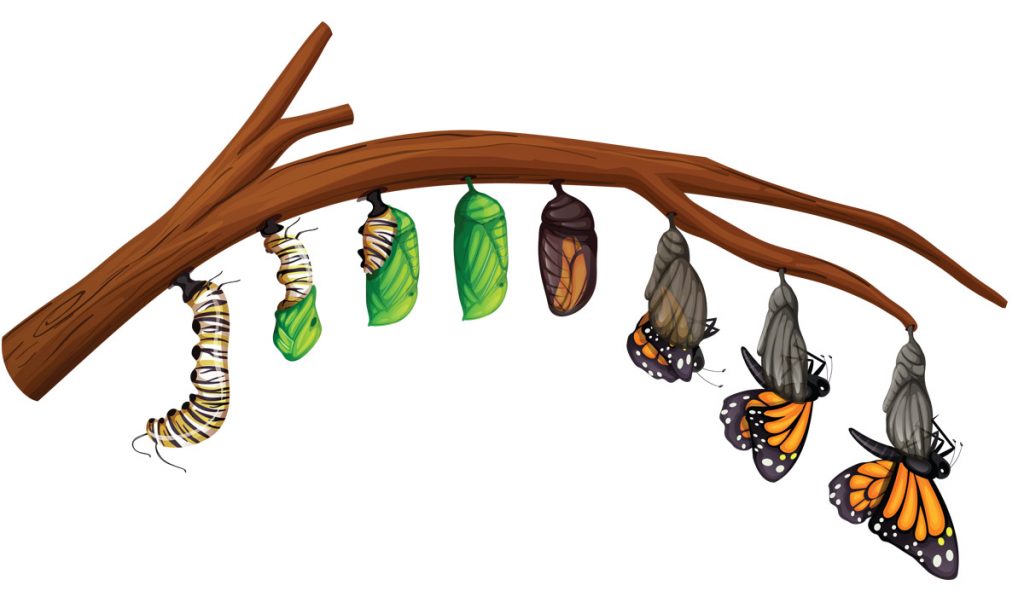In this module, you will find numerous resources that connect kids (and their adults) with the Monarch Butterfly. There are two activities in this module and they explore the “artistic form,” and “life science function” of this amazing insect species. The first activity provides you with an introduction to the Monarch, some ecological challenges it faces, and how people can help from home. The second activity features an exploration of symmetry in relation to one of our favorite insects …(drumroll please!)…the Monarch Butterfly! These activities are recommended for grades K-6th.
Activity #1: Introduction to the Monarch Butterfly
Just like a caterpillar changing into a beautiful butterfly, spring is finally here in Ventura County! The warm weather and longer days make it is a perfect time to observe animals and plants coming to life.
One symbol of spring is an insect that starts its life as a tiny egg on a leaf. This little egg then hatches into a colorful caterpillar, only eating the sap and leaves from the Milkweed plant. This caterpillar then goes through a second transformation, into a beautiful butterfly! Around California you might see this majestic orange, black and white insect called the Monarch Butterfly. Is there more than meets the eye to this brightly colored bug?
Find out more by watching the following video about this impressive insect, the Monarch Butterfly!
Resources to learn more:
To learn more about making a Monarch Butterfly “Waystation” at your home here are some additional resources:
If you want to attract Monarch Butterflies to your garden in time for next fall’s migration, spring is a perfect time to plant the native-plants that the Monarchs (and other beneficial bugs) need to live.
Native-plants like Milkweed use less water and typically require less maintenance. However, check with your local plant nursery or gardener for best practices in managing a garden that attracts beneficial bugs like the Monarch.
Activity #2: Symmetry and how to make your Monarch!
Symmetry is all around us, but what is it? Imagine a line that divide a shape in half. But each half makes a mirror image of that shape!

This short 2-minute video clip helps explain objects with symmetry and those without:
Go on a symmetry hunt and look for objects with symmetry in your room, backyard, patio, outside on a nature walk, or anywhere around you! How many things can you find with one side exactly like the other?
We recommend going on “nature walk” in and around your neighborhood. Walk around your local neighborhood, park, or yard to find animals, plants, and buildings that all show symmetry!
Do you see any butterflies or bugs today? Did they land on a plant or the sidewalk or grass? Can you take a picture of it or draw it on a piece of paper?
Note to parents: During this time of shelter in place/safe at home, be sure to continue to lead your family on walks, and approach nature observation sessions with your own health in mind—there is a lot of stimulation they can receive on the Internet, but the world outside (albeit in your immediate surroundings) is constantly changing and just as fascinating to explore! Just be sure to practice community health guidelines related to “social-distancing”.
The Monarch Butterfly has 4 wings, 6 legs, 2 antennae and 12,000 compound eyes!!!
This impressive bug is also perfectly symmetrical. Explore symmetry by making your own colorful butterfly by following some of the links to arts and craft activities below:
Take a picture of your Monarch creation and post it on the Agriculture Museum or Museum of Ventura County Facebook! We want to see everyone’s colorful creations!
Arts and Crafts Resources:
- Buggy and Buddy – Monarch Butterfly Symmetry Art for Kids **Recommended
- Deep Space Sparkle – Butterfly Painting Lesson **Recommended
- Gift of Curiosity – Hands-on Symmetry Activities
- Happy Hooligans – Monarch Butterfly Craft and Painted Coffee Filters
- Macaroonoriginal – Butterfly Life Cycle Coloring Activity
- Kid World Citizen – Butterfly Art for Kids
- How to Turn Your Backyard Into a Butterfly Friendly Habitat


